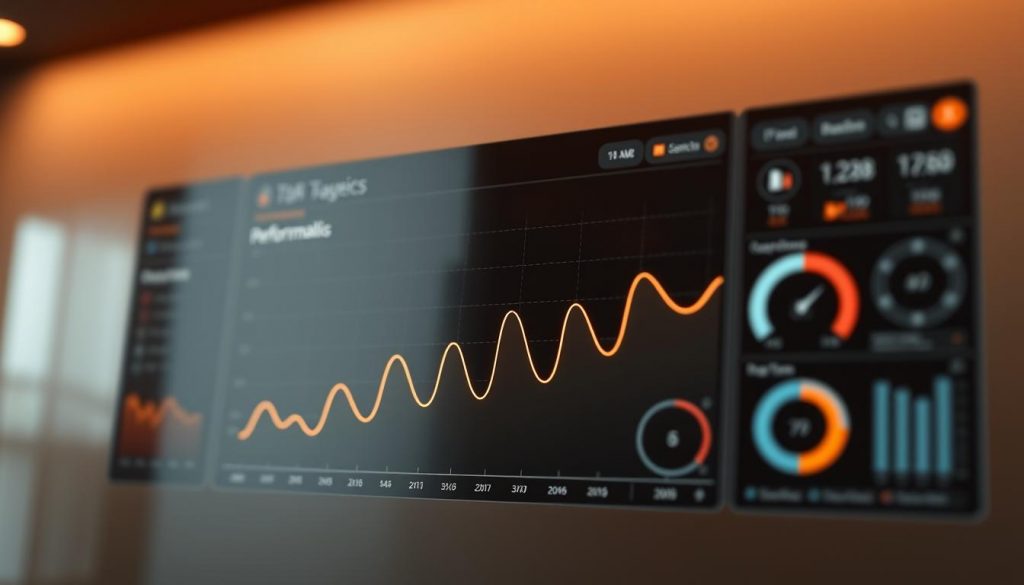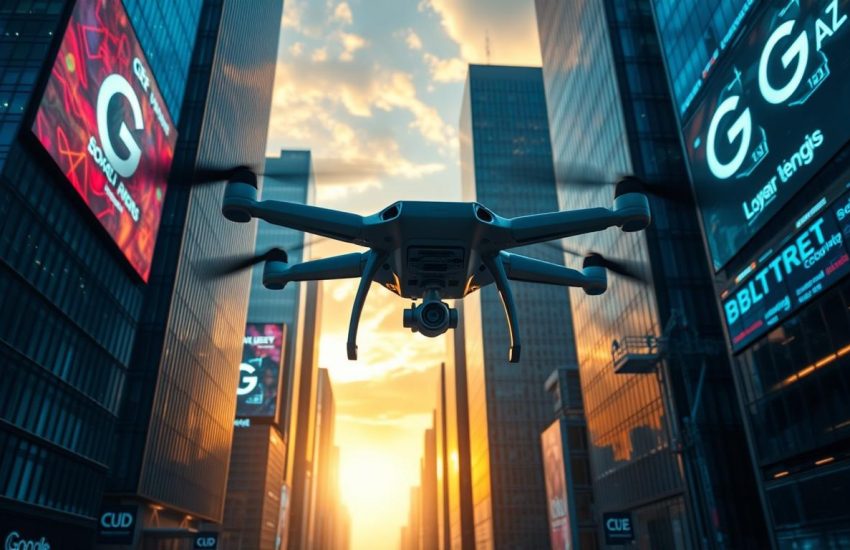Nearly 70% of search campaigns now use AI-led management tools. That shift is reshaping how we plan and buy media at scale.
We frame this change pragmatically. AI moves ads from static search listings into conversational answers and immersive formats. Predictive bids use first-party data more. Visual formats like AR try-ons and 3D displays are gaining traction.
For small and mid-size marketers, this means new choices and clear trade-offs. You must build stronger measurement and creative. You should test automation with guardrails. Expect faster experiments and tighter insight loops as platforms expose richer reporting on queries, assets, and audiences.
Our goal is simple: give you actionable steps to prioritize tests, allocate budgets, and grow with resilient measurement. We’ll separate hype from what drives results and show how current tools — Broad Match, Performance Max, and AI Max — fit into operational plans.
Key Takeaways
- AI is changing how you plan, buy, and measure search advertising.
- Pair first-party insights with cross-channel reach for advantage.
- Strengthen creative and measurement before scaling automation.
- Test visual and voice formats where they match intent and budget.
- Use current product capabilities to ground operational decisions.
Executive Outlook: Where Google Ads Is Heading in the AI-led Future
Industry forecasts point to rapid shifts in user habits that demand nimble media and measurement. We see three clear forces shaping what you buy, how you measure it, and where you show up.
Shifting user behavior and economic uncertainty
Shifting user behavior, economic uncertainty, and why agility defines marketing performance
Users now move between chat assistants, voice, and local experiences. That means shorter planning cycles and faster experiments. We recommend you build agility into planning so you can pivot spend as discovery patterns change.
Search formats and participation rules
From traditional SERPs to AI Overviews and GEO: what changing search means for advertisers
Assistants summarize results. To be eligible for AI Overviews, advertisers must use Broad Match, AI Max, or Performance Max. GEO optimizes content for conversational surfaces and interactive placements. This affects where your business appears and how you win attention.

- Diversify channels to protect profitability in uncertain markets.
- Prioritize privacy-first personalization to build trust and sustained engagement.
- Use clear reporting to keep control while you scale automation.
- Test small, instrument well — fast lessons beat big, slow bets.
| Area | Why it matters | Action |
|---|---|---|
| Eligibility | AI overviews favor integrated campaign types | Enable Broad Match or Performance Max |
| Measurement | Transparency helps guide automation | Instrument conversions and offline signals |
| Experience | Blended journeys change purchase paths | Optimize for voice, chat, and local intent |
AI, Automation, and Performance: How Google’s Stack Is Rewriting Campaign Strategy
Campaign strategy now centers on feeding automation with strong assets and accurate conversions. We’ll show practical ways to adapt.

Generative Experience Optimization and conversational search ads
GEO places ads inside conversational answers and updates them as queries refine. That means your creative and landing pages must match intent in real time.
Performance Max across channels
Performance Max automates creative assembly, placements, and bidding across Search, YouTube, Display, Discovery, and Gmail. Success depends on quality assets and full-funnel conversion tracking.
Practical tip: consider at least $50/day for PMax with robust conversion events and varied asset types.
AI Max, Broad Match, and PMax — when to deploy each
AI Max extends search reach without strict keywords while keeping clearer reporting than PMax. Broad Match unlocks unexpected intent when paired with Smart Bidding.
Smart Bidding evolution
Smart Bidding now uses first-party signals for predictive targeting and supports seasonality windows. Use it for short spikes like Black Friday and pair it with offline conversion values.
“Feed the machine with good assets, clean data, and patient experiments; the system rewards clarity.”
- Give automation audience signals, negative lists, and strong landing pages for better control.
- Split-test AI Max versus your current search setup to measure incremental results.
- Respect learning windows; avoid frequent bid or budget swings.
| Feature | Best use | Practical action |
|---|---|---|
| GEO | Conversational placements | Align copy to chat intents and update FAQs |
| Performance Max | Cross-channel scaling | Provide varied assets and full-funnel tracking; $50/day recommended |
| AI Max | Keywordless Search reach | Layer over keywords and monitor search-term reporting |
| Smart Bidding | Predictive spend allocation | Pass value, enable offline conversions, use seasonality adjustments |
Data, Signals, and Measurement: Building a First-Party Advantage
Strong measurement starts with the data you already own. Connect CRM events, purchase history, and consented streams so automation sees real value. This groundwork helps Smart Bidding learn higher-quality patterns and improves targeting over time.
First-party data as the backbone
We recommend mapping customer touchpoints and forwarding key events into your platform. Uploading customer lists supplies high-value signals even when not used for direct targeting. That boosts audience discovery and refines bid decisions.
Conversion tracking done right
Offline conversions matter. Link sales-qualified leads and closed-won revenue to ad interactions. This turns raw inquiries into business-weighted conversions and teaches automated systems to favor quality over quantity.
Audience signals, creative assets, and copy that teach the machine
Design audience signals thoughtfully: pair customer match, in-market segments, and custom intent. Use clear headlines, benefit-led images, and short video explainers to send stronger signals. Maintain clean event naming and deduplicate across platforms.
“Feed systems real value: profit proxies, LTV, and pipeline data make your strategy measurable.”
- Define primary conversions and value rules.
- Build feedback loops with sales and keep privacy central.
- Use reporting insights to iterate creative and targeting fast.
Immersive and Conversational Formats: AR, 3D, and Voice-Driven Search
Immersive tools and voice interfaces are changing how shoppers evaluate products on the spot.
AR try-ons and 3D displays reduce uncertainty for categories like beauty, apparel, furniture, and home decor. We advise testing AR beauty and apparel try-ons plus 3D product viewers to lift add-to-cart and conversion rates.
Voice search realities
Voice queries are longer and often local. Use natural, long-tail keywords and FAQ-style copy to match how people ask questions.
Local intent matters: keep business profiles, inventory feeds, and location extensions accurate for same-day or in-store fulfillment.
Mobile-first execution
With over 96% of users on mobile in Q2 2024, site speed and lightweight templates are essential.
Prioritize fast landing pages, mobile bidding, and short video for discovery. Tailor concise, benefit-led copy for conversational contexts to improve performance across platforms.
“Track how immersive experiences assist conversions — many users research in AR and return via branded search to buy.”
| Format | Best use | Practical tip |
|---|---|---|
| AR try-ons | Confidence in fit/appearance | High-fidelity assets; diverse body types |
| 3D viewers | 360° product inspection | Include clear product attributes and zoom |
| Voice-style copy | Local, long-tail queries | FAQ lines and natural phrasing |
- Coordinate formats inside Performance Max to let the system distribute placements across YouTube, Discovery, and search surfaces.
- Measure assisted conversions to see downstream impact from immersive trials.
Transparency, Control, and Budgeting in an Automated Landscape
When machines run bids and placements, transparency and steady budgets become your main levers. We focus on what you can directly control and what you must influence through setup and testing.
Black box to clear box: what you can (and can’t) see
Performance Max now shows search terms, asset-level performance, channel reporting, and audience insights. That gives you real signals to act on.
AI Max adds query-level creatives and the landing pages used. These features help explain why a campaign delivered certain results.
Experimentation frameworks: A/B tests and risk-managed scaling
Use the native experiments tool to test AI Max or Broad Match against your current search setup. Define success up front: ROAS, CPA, or incremental conversions.
- Control what you can: assets, goals, negatives, and budget caps.
- Set a minimum daily budget—we recommend at least $50 for PMax with full-funnel tracking and robust creative.
- Adopt phased scaling: raise spend slowly and avoid simultaneous bid and asset changes to protect learning.
“Good data and steady budgets keep bidding systems focused on business value.”
The future of Google Ads: Strategic Roadmap for U.S. Marketers
We lay out a tactical roadmap that helps U.S. marketers prioritize signals, creative, and channel mix through 2025.
Near-term priorities to 2025 and beyond: signals, creative, and channel mix
Define prerequisites before you launch Performance Max: plan ≥$50/day per campaign, full-funnel conversion tracking, and quality images and videos.
Prioritize measurement. Implement offline conversion tracking, set primary conversion values, and pass revenue or LTV proxies so bidding favors higher-value sales.
Upgrade signals and audience targeting. Upload customer lists, refine audience signals, and align assets so machine learning ramps faster and targets better.
- Run a strong Search foundation; test AI Max for incremental reach and deploy PMax when tracking and creative are ready.
- Build assistant-ready content: concise, benefit-led copy and structured answers for conversational surfaces.
- Refresh creative quarterly with new video and image variations to sustain ad performance across platforms.
“Set budgets that protect learning windows and use value-based bidding during peak events.”
Train your team to test weekly, document strategies and results, and invest in local fulfillment signals like Local Inventory Ads to speed sales.
Conclusion
Here are the concrete steps that turn strategy into repeatable wins.
Start by pairing first-party data and offline conversion tracking with disciplined bidding. That combination trains automation and shows real business value to advertisers.
Enable eligibility for Broad Match, AI Max, and performance max when assets and tracking are ready. Set steady budgets and clear conversion definitions to protect learning windows.
Lean on transparency tools to review search terms, asset signals, and campaign-level insights. Let platforms place media where users convert while you own product offers and creative.
We’ll keep testing. Run controlled experiments, document learning, and scale what drives revenue. That makes your advertising resilient and growth-focused.


